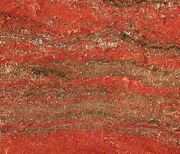
Iron is a metallic chemical element with the symbol Fe and atomic number 26. Iron is classified as a transition metal. Fresh iron surfaces are lustrous and silvery-grey in color, but oxidize in air to form a red or brown coating of ferric oxide or rust. Pure single crystals of iron are soft (softer than aluminium), and the addition of minute amounts of impurities, such as carbon, significantly strengthens them. Alloying iron with appropriate small amounts (up to a few percent) of other metals and carbon produces steel, which can be 1,000 times harder than pure iron.
Characteristics[]
The properties of iron can be modified by alloying it with various other metals (and some non-metals, notably carbon and silicon), to form steels with varying properties.
Nuclei of iron atoms have some of the highest binding energies per nucleon, surpassed only by the nickel isotope 62-Ni. The universally most abundant of the highly stable nuclides is, however, 56-Fe. This is formed by nuclear fusion in stars. Although a further tiny energy gain could be extracted by synthesizing 62-Ni, conditions in stars are unsuitable for this process to be favoured.
Iron (as Fe2+, ferrous ion) is a necessary trace element used by almost all living organisms. The only exceptions are several organisms that live in iron-poor environments and have evolved to use different elements in their metabolic processes, such as manganese instead of iron for catalysis, or hemocyanin instead of haemoglobin. iron-containing enzymes, usually containing heme prosthetic groups, participate in catalysis of oxidation reactions in biology, and in transport of a number of soluble gases.
iron is the sixth most abundant element in the Universe, formed as the final act of nucleosynthesis, by silicon fusing in massive stars. About 1 in 20 meteorites consist of the unique iron-nickel minerals taenite (35–80% iron) and kamacite (90–95% iron).
The red color of the surface of Mars is derived from an iron oxide-rich regolith.
Value[]
The base value of each unit of ranges between 1 and 5Ð per unit, with up to 10 units being found at any one time.
Presence on Mars: Very Common
| Martian Minerals | |
| Group 1 | Group 2 | Group 3 | Group 4 | Group 5 | Group 6 | |
| Group 1 | |Aluminum | Arsenic | Beryllium | Boron | Calcium | Cantite | Carbon | Chlorine | Chromium | Cobalt | Copper | Flourine | Helium| | Hydrogen | Iron | Lithium | Magnesium | Manganese | Nickel | Oxygen | Phosphorus | Plesium | Potassium | Silicon | Sodium| |